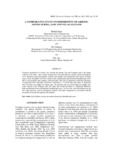| dc.contributor.author | Islam, Shriful | |
| dc.contributor.author | Rahman, M.S. | |
| dc.contributor.author | Das, R.K. | |
| dc.date.accessioned | 2012-05-02T10:11:40Z | |
| dc.date.available | 2012-05-02T10:11:40Z | |
| dc.date.issued | 2011 | |
| dc.identifier.uri | http://hdl.handle.net/10361/1802 | |
| dc.description.abstract | Transport mechanism of Arsenic (As) through the Surma, Sari and Volaganj sand is the prime
concern of this study. Three column leaching tests were performed to find the dispersivity property
of As. Numerous physical properties of these sand samples were determined and it shows Volaganj
sand is most permeable. From the collected data experimental and theoretical breakthrough curve
(BTC) were prepared and compared with each other. The value of dispersion coefficient and Index
of dispersion were calculated. Dispersion coefficient (773.763cm2/min) and index of dispersion
(844.3cm2/min) was higher for Surma sand. The leaching rate was found higher for higher pore
water velocity of the Volaganj sand. The study also reveals that there is a significant difference
between theoretical and experimental breakthrough curve. So not only convection/dispersion but
also other processes such as adsorption, reaction with other compound are associated with the
movement of arsenic through the sand medium. | en_US |
| dc.publisher | BRAC University | en_US |
| dc.relation.ispartofseries | BRAC University Journal, BRAC University;Vol. 8, No. 1 & 2, 2011, p. 23-30 | |
| dc.subject | Soil pollution | en_US |
| dc.subject | Arsenic movement | en_US |
| dc.subject | Dispersion | en_US |
| dc.subject | Breakthrough curve | en_US |
| dc.title | A comparative study on dispersivity of Arsenic among Surma, Sari and Volaganj sand | en_US |
| dc.type | Article | en_US |

